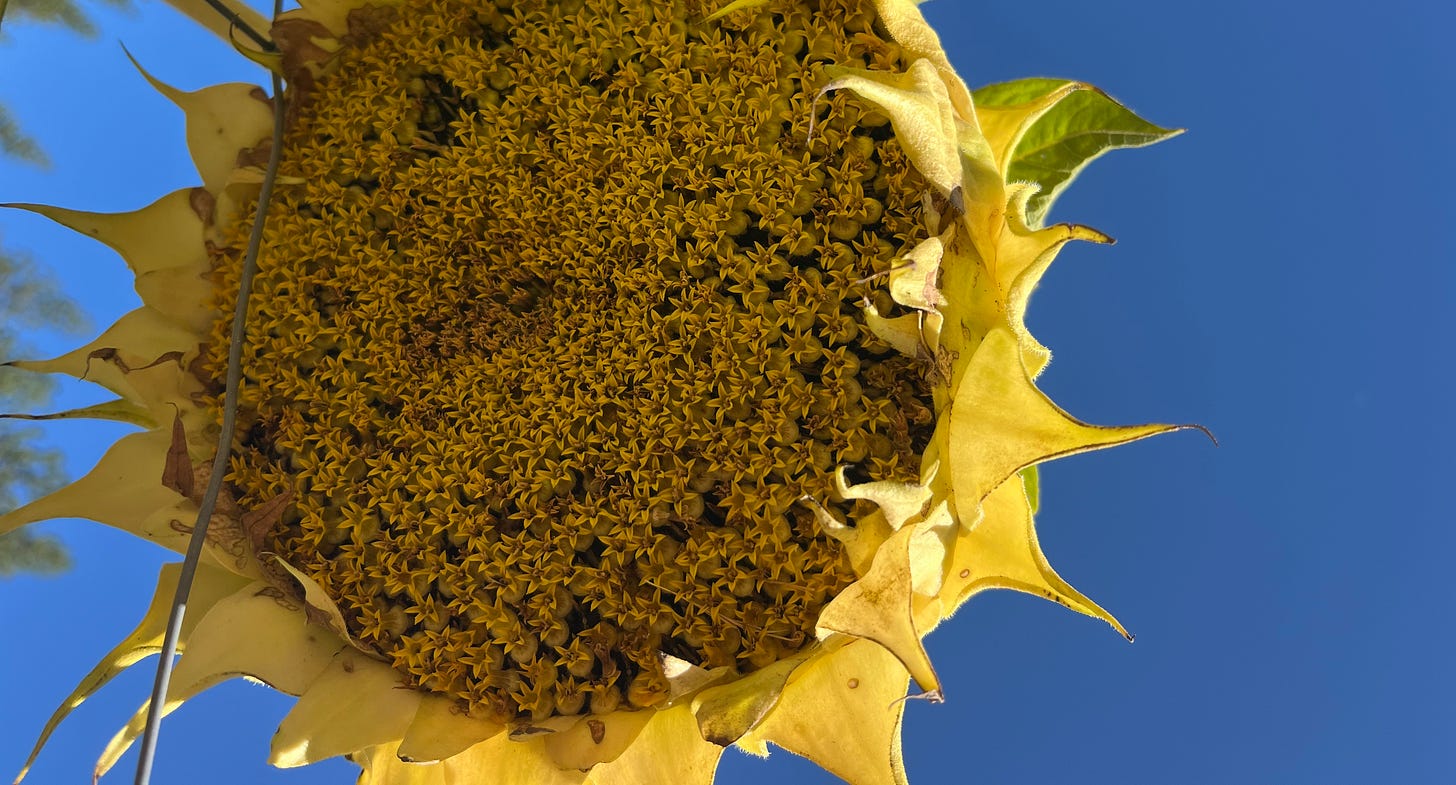Naming the ending from the start
On no exit relationships, and the intimacy of recognizing dying
A dying sunflower… going to seed.
Recently, I have been feeling how my twenties were a hazardous torrential whirlwind of figuring things out. The arena of relationships, a messy collision course of missed marks and worst-case scenarios enhanced by the continual necessity of cutting people out.
Somehow, survival looked like tossing people to the curb. Of declaring those who are worthy of love, and those who aren’t. In my twenties, my mind got used to using white-out pens to erase the lives of those who couldn’t match my tempo. The harshness of this technique was reflected in those around me, who were quick to sever, and diligent with sweeping away traces of a relationship gone haywire.
Severance is not outside the realm of nature. But its harshness and often, inability to treat all parties with dignity during its course, is a form of relational divorce. Of dismissing the shared work required for any project to flourish. Of choosing division and separation rather than reconnection and repair. Severance has become a well walked road.
What I long for is the ability to live and die well. A life lived in fear of relationships that’ll turn on us when things sour, creates the conditions for a scary living. Yet the reality of relationships is the reality of the world around us. All things end, and all things find new forms to be in.
Yet this society has not found its peace with death. It is something we hide from, dismiss, and ignore, in our obsession to prolong life as we know it. When we run from an aspect of what is true, we run from the gifts that this aspect of life… death (in this case), offers to us.
What if death meant, to be laid to rest in a way that honors the life that had been lived, while creating the space to grieve the release of the previous way of being? How might that change the way we meet our relationships when death of a way of being is imminent?
It has been my experience in my twenties, that death in relationships crept into unspoken denial, resentment fatigued stagnation creating anemic oxygen starved ferments, or vicious chain saw hacking of the tree we had once committed to tend and to love.
When it came to the inevitable change in relationships, the somatic expectation of my body, was to prepare itself for the shock of incoming severance. Though we might not want to admit it, or take responsibility for it, when a friendship ends abruptly, the impacts are felt.
This year, my 31st, I spoke a prayer to the waters: I hope to have the foresight to recognize when a relationship is changing, and to neither control nor ignore its presence. I hope to have relationships that no longer rely on dismissal, severance, or exiting as a strategy to safety. I am committed to, and ready for relationships that have the capacity to be for a lifetime.
It felt scary to say these words. For one, in the past, I’ve used the “forever timeline” to express my longing for stability. Ironically, this attachment to stability as the basis for a desire for long-term relationships is exactly what has prevented me from actualizing deep committed relationships that span the course of many years.
For this prayer of relationships that span a lifetime, or what Miki Kashtan calls, “no exit relationships,” we will adamantly be required to have a reverence for instability. When we become steadfast devotees to the dying process, there emerges the process of living life and death well.
In other words, when we get comfortable with the truth that whoever we get into relationship with, will no longer be the same person we initially met, we get to face the transformative potential of stretching within relationship to meet the other’s and our own changes.
In the past living experiments I have tried, I held onto the belief that things would grow in the same trajectory, of more of what we already had. Like the stock market, the trajectory could only go upwards, an arrow steadily climbing to heights that fortify a story that projects a kind of safety reliant on a future where we can be certain about how things will look.
This fear of uncertainty is at the heart of our inability to name the end. It is in our love for what has been, and our fear of an unknown future, where we hold on until it is too painful to keep reliving the story of what was.
Earlier this year, I was noticing disconnect with a good friend. We kept trying to meet each other in ways we had in the past, but it kept falling short of our expectations. When we finally got to the point of naming that things were ending, we were given the opportunity to cry together. It was a release that allowed me to honor the beauty of the relationship. It also gave me the permission to accept that the relationship as I knew it, was in the past, and I could no longer expect that from our relationship. It gave us the fertility to start anew.
Recently, I have been in a practice of naming endings from the beginning. To be in this practice means to boldly recognize the agency we have in how we hold our endings. It has allowed me to recognize that it isn’t about controlling or preventing change from happening, but to meet the change with containment that points to and ritualizes the shifting of the seasons.
To name the ending at the beginning is to intentionally create the space to notice the closing of stories, ways of being, and transitions before we are impacted by these changes.
For example, my current co-living experiment has created explicit time-bound containers for transition times, as well as a time-bound container for living together. It isn’t that we will necessarily disband after the container, it is that we are intentionally recognizing that by living together we will be changed, and that whatever we set as our agreements from the beginning, will need another moment of reevaluation as we evolve.
This allows for us to be explicit with naming what has ended as a whole group rather than as individuals where one person no longer see the relationship as “working” and chooses by themselves to step away. So often, these relationships end unilaterally, where one person separates without any sort of co-discernment.
If we want to live into the kind of world in which we have choice and agency to decide our fate, our relationships can become our greatest practice field. So much of our society is moving in the direction of control and power by a select few, and it can feel disempowering to believe that this is all we can expect in our lives.
Yet, our relationships are the foundational structures in which all life flourishes from. The relationships that we have grown up experiencing, do not have to be the blueprint in which we are beholden to.
Rather, we can direct our flow towards changing our practices with our beloved relationships by naming the reality of future changes and creating the culture of how we want to respond when that time comes.
It takes work, capacity, and commitment to be courageous enough to name the end at the beginning. As I continue to rotate with this planet amongst all the beings around me, I feel clearer than ever, that to be bonded for a lifetime requires the kind of ferocity towards the purpose of moving at the pace of togetherness in which we can renew our relationships death after death after death.






i love this so much